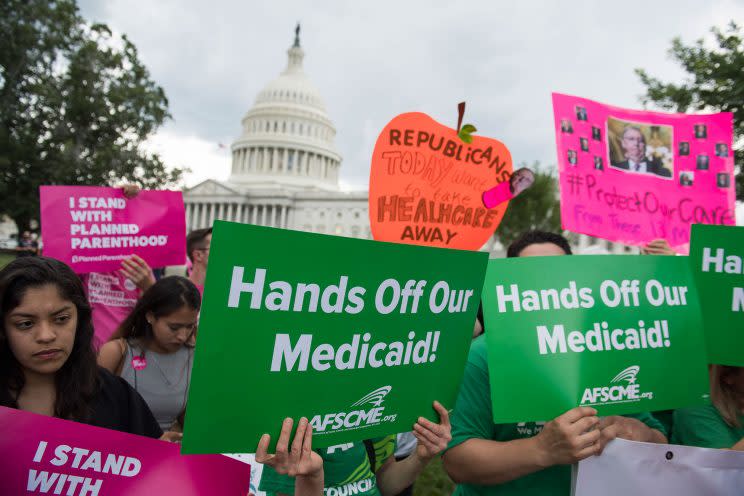Potential Effects of Planned Parenthood Defunding in Alaska: Devastating, Says New Report

The proposed and hotly divisive Senate bill called the Better Health Care Reconciliation Act bars Planned Parenthood from receiving Medicaid reimbursements for one year. And while no state would come out unscathed with such a plan, Alaska would be the “single most harmed state” in the entire country if this bill becomes law, the Center on Budget and Policy Priorities determined recently.
A new report not only confirms that grim picture but offers details on how Alaskan women would be affected, according to findings shared exclusively with Yahoo Beauty on Thursday.
The analysis, from Health Management Associates, a national health care research and consulting firm, makes clear that defunding Planned Parenthood in Alaska — that is, barring it from participating in the state’s Medicaid program — would be devastating to Alaskans, especially those living in rural areas.
The health care landscape in Alaska, it explains, is already rife with barriers: 34 percent of the state’s residents live in rural areas, and 22 out of 29 of Alaska’s boroughs do not have any obstetricians and/or gynecologists.
Further, in 2016, 29 percent of Alaska women ages 18 to 44 with an income less than 100 percent of the Federal Poverty Line (FPL) were uninsured, and 57 percent of those women were Medicaid beneficiaries. Meanwhile, Alaska has higher overall rates of sexually transmitted infections (STIs) than the comparable nationwide rate, with 789.4 chlamydia cases per 100,000 people in Alaska, compared to 478.8 cases per 100,000 people nationally, and 154.2 cases of gonorrhea per 100,000 people in Alaska, compared to 123.9 cases per every 100,000 people nationally.
Likewise, the teen birth rate in Alaska is higher than the U.S. average, with 33.5 births for women between the ages of 15 and 19 statewide, compared to the nationwide rate of 24.2 teen births per 1,000 young women in the age group.
The Health Management Associates study looked at four Alaskan boroughs to examine the potential outcomes of preventing Planned Parenthood from serving as a Medicaid provider in the state. In those boroughs, there were only 15 health centers that received federal funds to provide family planning and reproductive health care to Medicaid beneficiaries. And four of those 15 clinics were Planned Parenthood health centers. Planned Parenthood, in 2015, served a total of 7,672 Alaskan patients who visited the health centers over 10,300 times. And 26 percent of these patients? Medicaid beneficiaries.
Planned Parenthood health centers were the only clinics in the four boroughs studied that participated in the state Medicaid program and offered a broad range of reproductive care via telemedicine — as well as offered same-day intrauterine device (IUD) insertion.
“If Planned Parenthood health centers in Alaska can no longer take care of Alaskan women, other providers cannot fill the gap,” the Health Management Associates report concludes. This was the conclusion after researchers called and reviewed the websites of the 11 alternate, non-Planned Parenthood providers in the area of focus. While seven of these providers provide reproductive health services for Medicaid beneficiaries specifically, it’s unclear whether or not they have the means to absorb the influx of patient volume from Planned Parenthood.
Even with a handful of alternate providers serving Medicaid beneficiaries, the report concluded, the potential for Planned Parenthood patients to be successfully absorbed by these remaining providers is very low. Furthermore, the researchers state, “No alternate provider with services comparable to those offered by Planned Parenthood exists in any of the four boroughs under study.”
The researchers pointed out that two of the seven alternate providers did not offer same-day IUD insertion, and four of the seven didn’t know whether they do or don’t provide this service.
“The implications of these results are clear: without a same-day option for IUD insertion, women would have to schedule another appointment on a different day and return to the clinic for IUD insertion. This means that women already challenged by barriers to care would confront additional obstacles. Evidence demonstrates that when women are required to return to a health center for an IUD insertion, many fail to return and thus do not obtain the contraceptive device of their choice, or that services are delayed, which may result in an unplanned pregnancy.”
Of course it’s not just less access to IUDs that’s on the line should Planned Parenthood be barred from the Medicaid program. It’s fewer STI screenings and less contraception delivered to those in rural areas through telemedicine, adding up to even more woes for Alaskans already facing adverse circumstances due to their financial condition and their geographical location.
This analysis of what could happen in Alaska comes on the heels of four Planned Parenthood health centers closing in Iowa on June 30, a result of state defunding efforts there that blocked Planned Parenthood from serving as a Medicaid provider in the state. As a result, it is expected that 15,000 Iowans will lose access to reproductive health care services.
(It is important to note that Planned Parenthood is not directly funded by the federal government. It simply receives reimbursement for services rendered through Medicaid and Title X, the federal family planning program.)
What just happened in Iowa — and what the Health Management Associates report indicated could happen in Alaska — could be a preview of what stands to happen across the country should Congress pass “Trumpcare,” the GOP plan to repeal and replace the Affordable Care Act. And by the estimation of these researchers, just for starters, the possibilities could be horribly life-changing for countless of American women.
Read more from Yahoo Style + Beauty:
Trump Signs Law to Cut Funding for Abortion Providers: Here’s Who It’ll Impact
Everything Women Need to Know About State Attacks on Reproductive Rights This Week
Follow us on Instagram, Facebook, and Pinterest for nonstop inspiration delivered fresh to your feed, every day. For Twitter updates, follow @YahooStyle and @YahooBeauty.

